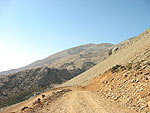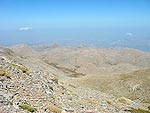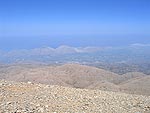Crete´s highest mountain stands In the middle of the island. It is the Psiloritis - also called the Ida mountain.


The following 10 km, the gravel road winds upwards through formidable hairpin bends.




Psiloritis
|
Αυγή τσ' αυγής θα σηκωθώ με τ' άστρα με φεγγάρι, |
Before dawn I'll wake up to the stars and the moon, | |
|
να πάω να ξημερωθώ εις τον Οψηλορείτη. |
and see the early morning-glow from the peak of Psiloritis. |
|
Μαδάρες μου Χανιώτικες, κορφή του Ψηλορείτη |
The White Mountains at Chania, but highest the Psiloritis, | |
| και Λασιθιώτικα βουνά, γεια σου παντέρμη Κρήτη. | and the mountains of Lassithi - hail proud Crete. |
| On the top of Psiloritis stands
a stone church dedicated to Timios Stavros (The Holy Cross). It also
existed in 1893 when Vittorio
Simonelli visited the mountain,
but has later been renovated by the Moundakis family in memory of the late
musician Kostas Moundakis.
|
|
||
| There is of course
also a breathtaking and magnificent view of Crete:
|
|||
 |
To the east is the summit of Angathias, only 32 m lower than Psiloritis. | ||
| Further out in the horizon on the Skinakas mountain (1752 m), the dome of the observatory reflects the sunbeams, and furthest out in the horizon you can just make out the Lassithi mountains. | |||
 |
To the north you see Anogia and the other villages all the way down to the coast. The coast itself is however hidden by the elegant peaks of the Kouloukonas mountains. | ||
| To the northwest towers the pointed peak of Stolistra in the immediate vicinity, and there is a formidable view down over Rethymno and Iraklion. Furthest out in the horizon you faintly see the tops of Lefka Ori. | |||
 |
To the southwest you see the big Kedros mountain (1777 m) and the Siderotas mountain (1177 m) with its surrounding mountain tops. | ||
| To the south the large fertile Messara plain spreads with the Asterousia mountains as background, and the most southern point of Crete, the Lithino headland with the relatively big Kefala rock. | |||
 |
To the south east is the Mavri mountain (1981 m) with its two peaks. The mountain has got its name which means dark, because - when seen from the north - it is considerably darker than the surrounding mountains. | ||
|
|
|||
| Psiloritis is today accepted as a nature reserve in Leader II because of its great natural richness with numerous endemic plants and insects and with the peculiar conduct of life and the unique traditions that the inhabitants of the area have evolved in harmonious co-existence with the mountainous nature. |
|
||
| The nature reserve is split up into four subgroups: | |||
| 1. "Psiloritis" consisting of the actual mountain range. | |||
| 2. "The Cave Reserve", consisting of the most important caves of the area (Idaion Andro, Zoniana, Kamaraki). | |||
| 3. "The Mountain and Plateau Reserve" at the south east slopes of Psiloritis, showing the characteristic transition between mountain and plateau. | |||
| 4. "The Talaia Mountains", consisting of the Kouloukonas mountains at the north coast. | |||